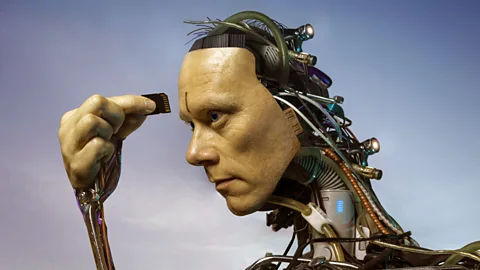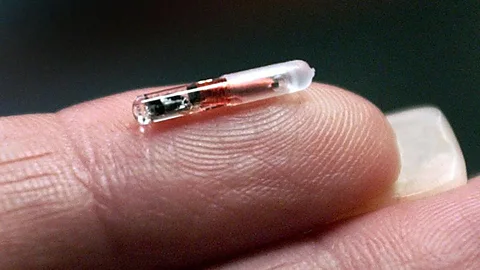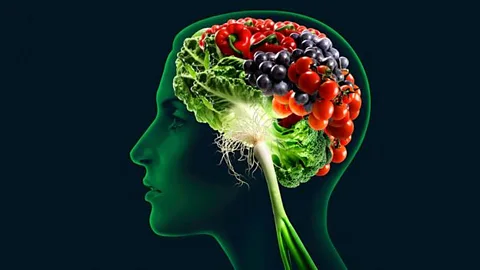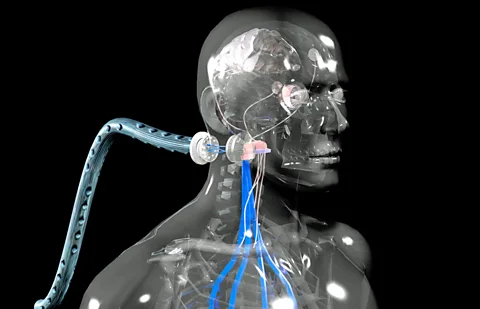Cyborgs: The truth about human augmentation

What is it like to be a cyborg? In his last regular column for BBC Future, Frank Swain explores the biggest misconceptions about bionic limbs, microchip implants and beyond.
At the height of summer, when London was baking in unseasonable heat, I made an ill-fated trip to the Serpentine lido in central London. The Serpentine is a small lake in the heart of the capital where bathers have cooled off since the 18th Century. Leaving my clothes by the side of the lake, I plunged under into the refreshing water, only to hear it crackle around me in a peculiar way. I’d forgotten to take out my hearing aids. And just like that, the greenish waters of the Serpentine washed away my new-found hearing.
The next day the devices were still lifeless little pebbles, one red and one blue, and I was lucky that my audiologist had an opening the following evening. I expected to be put in the doghouse when I explained what had happened, but he was delighted. “This tells me your brain has adapted perfectly to the devices,” he smiled.
There’s a cost to this tightened integration, though. My brain is no longer tuned to life without prosthetics. Without my hearing aids, I hear worse than I did before I got them. The little electronic plugs have become an extension of myself. Although I can be physically separated from my hearing aids – I can take them out and hold them in my hand – my sense of hearing is not so easily picked apart. It exists partly in my ears, and partly in my devices.
So I am now a cyborg out of necessity, not choice. Being part machine is my resting state. Yet I don’t feel much like Robocop or the Six Million Dollar Man. If I am a cyborg, shouldn’t I feel more, well, superhuman?
There’s a big gulf between the fantasy vision of cyborgs, and the current reality of being dependent on an implant or a prosthetic in day-to-day life. If we’re to separate the two, we ought to pay close attention to those who are living in that world already.
For this last column in my Beyond Human series, I spoke to a variety of very different people who I encountered this year. Each have embraced the idea of human enhancement, from an artist who hears colour to a man who can start a motorbike with a chip implanted in his hand. What secrets can they share about life as an enhanced human?

“It’s a myth that human augmentation is anything new,” says Amal Graafstra, the microchip implant pioneer I interviewed back in February. “Since the first humans picked up sticks and rocks and started using tools, we've been augmenting ourselves.” The tools have simply gotten smaller and less cumbersome to use. “That has always been the trend, and that will continue to be the trend. From rudimentary objects like rocks and sticks, through forged steel and circuit boards, and onward to gene therapies – the common thread is transhumanism; to constantly and fundamentally transform the human condition.”
This idea of transformation is often cast as risky. In science fiction, stories abound that technological enhancement will lead to a society of haves and have-nots. So does transhumanism offer a stark choice of evolve or perish?
“Some would express fear that emerging augmentations would create an arms race, that threatens to leave behind those who choose not to be augmented,” agrees Gennady Stolyarov, who told me in April that death was not inevitable. “But this assumes everyone will seek to compete with everyone else.”

Stolyarov foresees a different outcome. Instead of relentlessly optimising ourselves to a model of perfection, he predicts an explosion of diversity. “Different people would choose to augment themselves in different ways, stretching their abilities in different directions. We will not see a monolithic hierarchy of some augmented humans at the top, while the non-augmented humans get relegated to the bottom,” he reasons. “Rather, widespread acceptance of emerging technologies would create a future where a thousand augmented flowers will bloom.”
I prefer Stolyarov’s vision of the future, and it’s one I subscribe to. Mass literacy didn’t result in everyone competing to read the same books, it created a market for everything from pulpy romance novels to weighty tomes on ancient history. People explored the ideas they felt expressed themselves. There’s no reason to think future human technologies won’t play out in the same way.
Yet I’m not alone in thinking that this future of cyborgs won’t necessarily mean that we’ll all feel superhuman. When Paul Carter was young, doctors gave him so many specialised prosthetic limbs that he resembled a human Swiss Army knife. He points out that augmentation isn’t a magic bullet that will instantly give you incredible abilities – or even abilities as good as the next human. “Putting blades on someone doesn't automatically make them a superstar runner,” he says. “The underlying prerequisites of talent and fitness are still necessary. The developments that have been made in augmentation possess incredible potential to transform the lives of many disabled people, but they need to be looked at as a part of a wider social picture, and not solely as a means to an end.”

Gabriel Licina, who experimented with unlocking infrared vision in humans, seconds that notion. “The myth to dispel is that with an augmentation, people will easily become superhuman. It's important that we stay grounded in scientific reality. This doesn't mean that there isn't room for improvement, it just means that it's not as easy as just popping a pill or flicking a switch.”
Licina gives the example of his own research: subjects found they could improve their night vision by tweaking their nutritional input, but only at the cost of losing some of their blue/green perception. Transhumanism often suffers as a form of wish fulfilment: a lot of people will tell you they’d like to be able to fly, but these very same people can rarely be bothered to go running. Augmentation ought to be seen less as a solution than as a tool you can use to build yourself in new directions. (And who knows, maybe if you train yourself to run fast enough, you might start flying. There’s only one way to be sure.)

Licina’s research also raises the important point that augmentation doesn’t have to be about technology. You don’t need to have a chip implanted in your brain to be enhanced – it can involve biological tricks too. This theme was picked up by John Cryan, who told me how the bacteria in your gut can make you smarter: he reminds us not to get too hung up on wires and microchips. “When we talk about brain augmentation, it is vital to think also below the neck. Neuroscience must understand the importance of signals from the periphery: from the immune system, gut hormones or microbes.”
Nonetheless, visions of souped-up humans go hand in hand with moralist visions of hubris preceding a fall – a tale as old as humanity itself. When humans begin to augment themselves to extremes, some people say, we might lose control of ourselves. Anyone who has sat through a meal in silence as fellow diners tap incessantly at their smartphones knows that technology can be addictive. Thankfully, Stuart Meloy, who I spoke with about his device that can deliver pleasure at the push of a button, says there’s hope for humanity. “One concern that was expressed with pleasure implants was the use of the device to point of distraction or neglect of self, like the proverbial rats that starved to death because they had a choice of pushing a lever for food or getting an electrical stimulation of their pleasure centres in the brain. But there were no onanistic comas on my watch. Humans are more complicated than rats.”

Nonetheless, there will always be those who oppose transhuman aspirations with the put down that they are unnatural. This has always struck me as a strange criticism. Usually it means someone is trying to define humanity as something that looks just like him. Neil Harbisson, who wears an antenna that allows him to hear colour, debunks the idea that it is anything unnatural. “Some might think that we might become less human if we modify ourselves but I believe there is nothing more human than doing that,” he says. “I strongly disagree with those who think that our union with technology will alienate ourselves from reality, from nature or from other livings. In my case, becoming technology doesn’t make me feel closer to machines, or to robots, but quite the opposite. Having an antenna makes me feel closer to insects and other creatures that have antennae, hearing through bone conduction make me feel closer to dolphins and other marine species that perceive sound through their bones, having ultraviolet and infrared perception makes me feel closer to insects and mammals that perceive these colours. I feel a stronger connection with nature now than I ever did before. Technology can bring us back to nature.”

Now the British summer is drifting steadily into autumn, my swimming trips are becoming less regular, but the question over how far my body can integrate with machinery is still at the forefront of my mind. I know I might never be superhuman, but that’s not going to stop me exploring the many ways technology and biology can augment my abilities.
Soon, I’ll be fitted with a unique set of hearing aids, currently being prototyped in a studio in south London, which will report not just the acoustic world around me, but translate invisible electromagnetic fields into sounds I can hear. Will my brain adapt to this as readily as it adapted to a refreshed acoustic environment? Will being able to sense the electromagnetic environment change the person I am? Only time, and lots of practice, will tell. It’s a step into the future, and who knows where it might lead? One day, cyborgs like me might even be waterproof.
